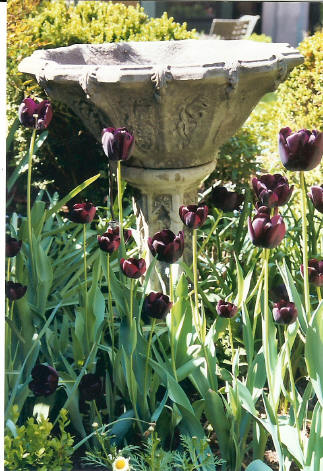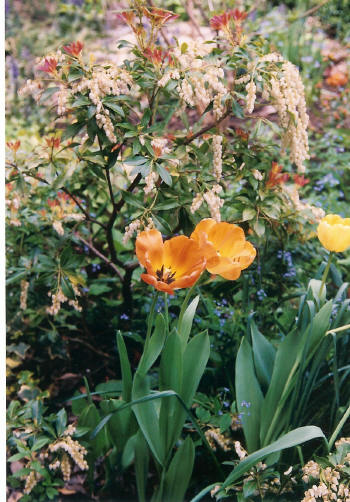Linda Moran
Frederick County Master Gardener
 With the exuberance of summer color fading and a break from feeding, watering and deadheading in sight, it may be time to turn your energy toward plotting a spring show of bulbs for
your garden. When it comes to ease of planting and spectacular bang for your buck, bulbs win best in show every time. Further, if you follow the optimum-planting schedule you'll be able to ease those winter garden blahs by contemplating the splendor to come.
With the exuberance of summer color fading and a break from feeding, watering and deadheading in sight, it may be time to turn your energy toward plotting a spring show of bulbs for
your garden. When it comes to ease of planting and spectacular bang for your buck, bulbs win best in show every time. Further, if you follow the optimum-planting schedule you'll be able to ease those winter garden blahs by contemplating the splendor to come.
It is tempting and easy to stick with the tried and true crocus, daffodil, and tulip combination but with a little imagination and sleuthing you will discover that there are a wealth of bulb varieties. Nothing quite lifts the gardener's heart like the sight of a bunch of Snowdrops (galanthus)
pushing their way up through the snows of January and February or the simplicity and beauty of a soft lavender Tommie crocus (c, tommasinianus) rising three inches above the brown leaves under the warm March sun. Early cheery daffodils, showy species tulips, muscari and Trout Lily (erythronium), Spring Snowflake (leucojum
aestivum), Glory of the Snow (chionodoxa luclliae), and the lovely soft blue starflower are all readily available and should be considered if you can stretch your gardening budget to do so. And squirrels do not seem as interested in smaller bulbs - a real bonus. Minor bulbs I have particularly enjoyed are the muscari -
there are over 50 types available, Grecian Windflowers (anemone blanda) especially in blue and white, Festival Hyacinths, which are very fragrant and compact, Spring Snowflakes, (leucojeum) which belong to the amaryllis family and are tall slender stems hung with white bells tipped with dots of green,Wood Hyacinths (scilla
nonscript) and Dogtooth Vioiets (erythronium) which I have fond memories of picking in May from a marshy area in a meadow on our farm. The Kaufmanniana, Species and Greigii Tulips are a delight in early spring and the Alliums round off the spring bulb season with their tall slender stems that bear ball-shaped blooms in
shades of lilac purple and violet. Mount Everest and White Giant are two striking white varities.
 In terms of planning where to plant, gardeners don't need to worry about foliage providing too much shade -- bulbs will be up and blooming by the time heavy leaf cover appears.
However, avoid root interterence from trees and large shrubs and keep away from moist areas. Most bulbs ( the Trout Lily is an exception) will not thrive with wet feet and summer over-watering can be shorten their "perennial" lifespan. The thorniest challenge always is to avoid disturbing the bulbs you have planted in
years past in your eagerness to add another perennial or annual to your garden. To avoid this, use a system of marking and labeling-- if you are able to be so organized.
In terms of planning where to plant, gardeners don't need to worry about foliage providing too much shade -- bulbs will be up and blooming by the time heavy leaf cover appears.
However, avoid root interterence from trees and large shrubs and keep away from moist areas. Most bulbs ( the Trout Lily is an exception) will not thrive with wet feet and summer over-watering can be shorten their "perennial" lifespan. The thorniest challenge always is to avoid disturbing the bulbs you have planted in
years past in your eagerness to add another perennial or annual to your garden. To avoid this, use a system of marking and labeling-- if you are able to be so organized.
Another important consideration is bulb foliage. Try to plant near shrubs or perennials that will help cover the leaves as they turn brown and become unsightly. This is especially true for daffodils whose foliage lingers the longest of all the spring bulbs. Although it is tempting to remove the
bulbs' foliage, tie it in knots or braid it, don't! The bulb uses those leaves as food for the next year's bloom. Planting your tulips and daffodils (the biggest offenders) behind a plant that will grow taller after the bulbs have bloomed is a practical solution. The dying foliage of smaller bulbs can easily be obscured
with plantings of candytuft, violas, brunnera, hostas, ivy or any of the more common groundcovers.
An equally important aspect of planting is to visualize how bulbs will look in terms of color combinations with nearby plants and shrubs. One of spring's pleasures is seeing how well the Princess Irene Tulip compliments the leaf coloration of the Mountain Fire Peris and how striking the Queen of the
Night tulip looks against the gray blue spikes of Lavendar Grosso and the gray tones of the bird bath. Also, you will have a more pleasing show if you clump your bulbs. I prefer planting in groups of odd numbers of at least
7 or more when it comes to tulips or daffodils. With the smaller minor bulbs you will need many more to make a statement. Once the bulbs are in the ground a light covering of mulch and a thorough watering will take care of their needs.
Although bulbs tend to be rather forgiving of poor soil, increase your odds for optimum flowering and longevity by adding humus to a heavy clay soil or an overly sandy soil. Fertilize sparingly with a little bonemeal under the bulb when planting. I generally use a small shovel when planting as I can
loosen the soil better and also ensure that I am planting the bulbs deep enough. This is especially important for tulips and generally your efforts will be rewarded with larger flowers and more years of return blooming.
Since bulbs can be planted in our area from late September through November, choose a day or days when the weather is fine and you won't be tempted to rush through your task.
When you are ready to purchase your bulbs you will be faced with a huge array of choices - especially of tulips and daffodils. Stick to a few colors that will complement your garden and choose bulbs that have varied blooming times, which will provide a show for several months. Some research in
gardening books and catalogues and on the internet will help you to become familiar with the characteristics of each as well as their virtues. An important tip is to buy your bulbs as early as possible so they're not damaged by overexposure to the heat of warehouses and stores. Buying wholesale is best for price and
variety, and there are probably hundreds of catalogue sources out there, including ColorBlends and Van Engelen, Inc.. The Old House Gardens catalogue features an interesting variety of heirloom bulbs dating from the 1500's. Further, most nurseries have a wide variety of bulbs available. Visit more than one to broaden your
knowledge of the many gorgeous varieties out there.
Happy digging.
Read other articles on garden and landscape design
Read other articles on plants and flowers
Read other fall related gardening articles
Read other article by Linda Moran